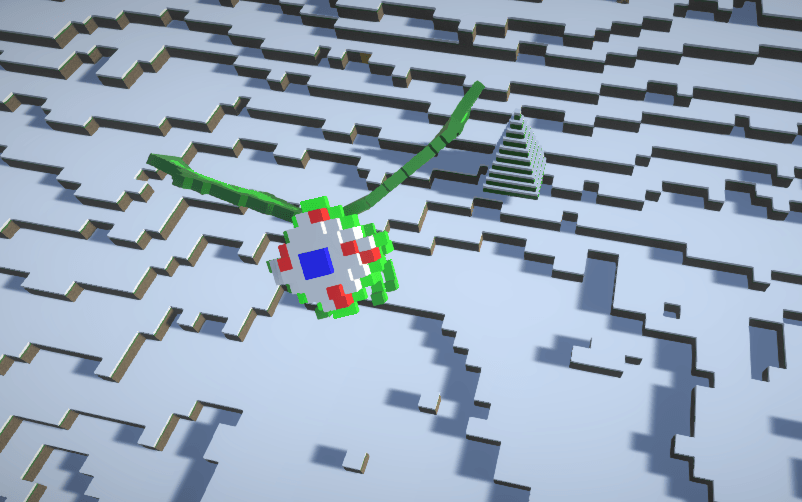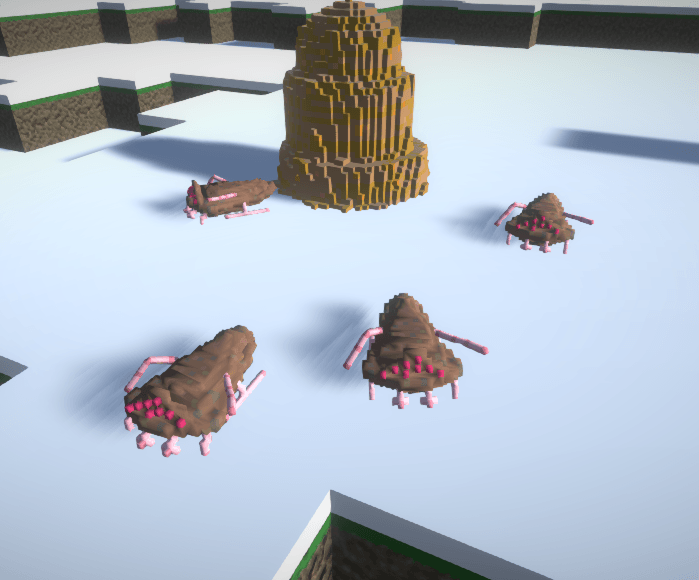Notes on Eldritch Fauna – Dev Blog 8
Hello and welcome to Friday’s regular development blog. This week we have been very busy adding life to the fauna of Fringe Planet. Up until now, only two types of entities have been living in The Void – the peons and something very evil we haven’t spoken about yet. So this week we have added two new creatures to the game – the EyeBird and the “Bug with Many eyes” (placeholder names).
Both of these creatures use placeholder graphics and interact very differently with the world. In this blog post, we will go over the systems we use to give these creatures life, and explain how they will ultimately interact with the environment and the peons.
The EyeBird
The EyeBird is a flying quadruped whose main diet consists of small insects that can be found around certain plants in Fringe Planet. About the size of a large dog, these flying creatures spend most of their time moving between the various floating islands they find in The Void. The fly at an altitude at around 100meters above the surface of a floating island and will exhibit various types of behaviour while they are up there. Behind the scenes; a boid simulation is running. Most of the time the EyeBirds will fly about keeping an eye on the environment around them – however when they get into range with another EyeBird, the two may start to form a flock. This flock will grow as other EyeBirds approach it, and may also shrink, as the attention of EyeBirds inside the flock is diverted.
The EyeBirds need to both eat and sleep. And this will trigger two different reactions. When an EyeBird is hungry, it will travel down to a lower altitude closer to the surface of the floating island. And from this lower altitude it will look for the closest plyme tree or pine tree, and when it discovers one that has insects around it – it will enter a steep dive. It will munch the insects in mid air after this steep dive and will slowly digest the insects as it returns to it’s standard altitude.
When an EyeBird is tired, it will lower in altitude and take a few seconds to scan the floating island below, seeking out a spot to settle. This spot will be away from both peon activity and away from player placed voxels. Once a suitable spot has been located, the EyeBird will slowly drift to that spot and sleep – slowly restoring it’s energy.
The Bug with Many eyes
The “Bug with Many eyes” is a small tentacled, many legged omnivore which is about the size of a large rat. These incredibly fast creatures will zoom around the map, eating anything they can get their tentacles on – everything from grass to dead peons will be munched upon by these creatures. When a source of food is discovered, this creature will use it’s many legs and tentacles to turn the food into a disgusting gloop, which is then sucked up by the tendrils on the front of it. The life cycle of these creatures are very different to anything we have on Earth – once full of food, they will return to a point where they have established a nest of rotting organic material. The bug will then “feed” the nest, injecting part of this gloop directly into a central chamber. Shockingly, as the chamber fills up, a new “Bug with Many eyes” is formed and promptly unleashed into the environment.
These two bugs will continue this cycle, meaning there is almost an exponential growth that occurs within the colony. However, when ten of these bugs are present in a single colony – it will stop producing more. However, it will send out a bug which can start a new colony. And thus the cycle begins again.
These creatures, as long as they are fed, are no harm to the peons. They will eat the waste and just breed, mostly ignoring the peons. However, should they run out of food (most likely from too many bugs being present on the island) they will get desperate and begin attack the peons. As their numbers increase quickly, and as they are edible (when prepared and cooked) it is a good idea to regularly hunt them, as well as destroying any extra colonies that are formed.
More creatures to come…
These two creatures contain multiple different behaviours, which we can use in a building block like fashion to create additional creatures. And, more excitingly, these represent the bottom of the food chain in Fringe Planet (along with the peons!) – expect to see some more creatures joining these in the up and coming months.
Thanks for reading this weeks development blog! Let us know what you think!
There is a lot more to read about Fringe Planet… why not try:


